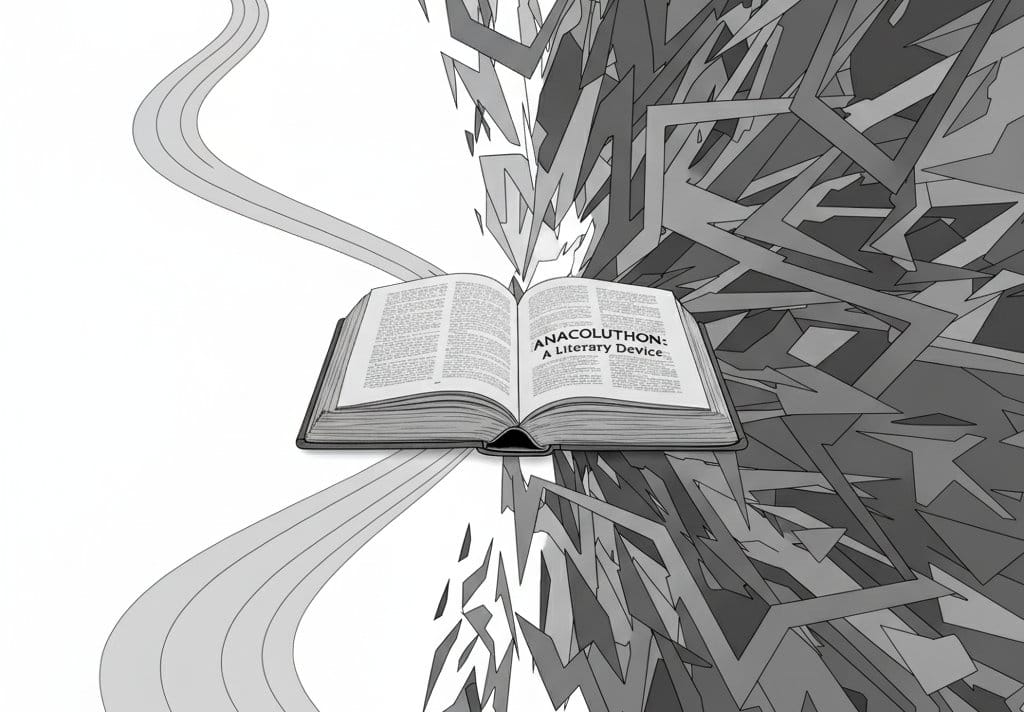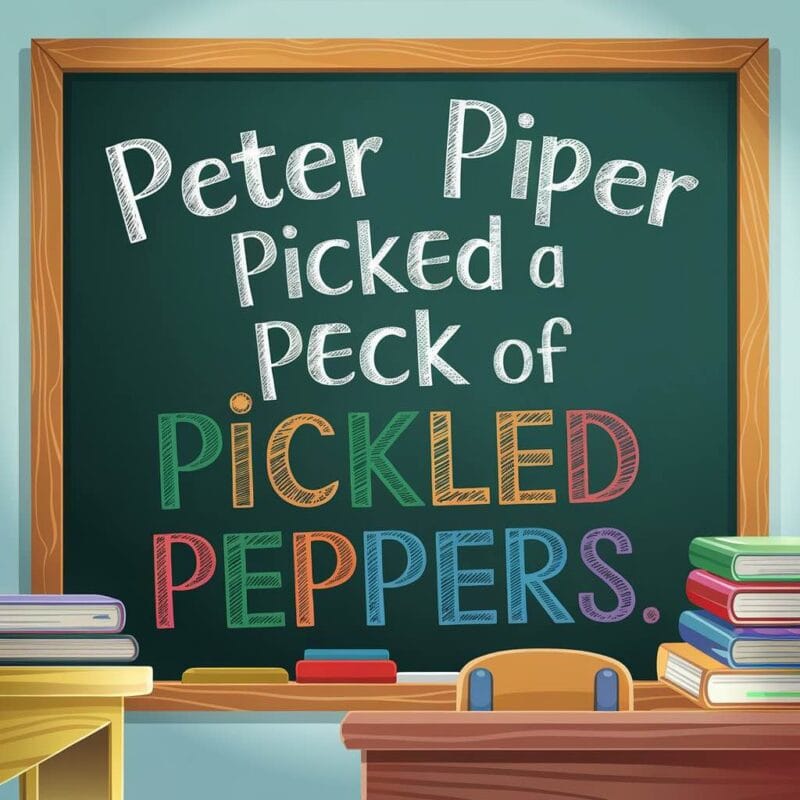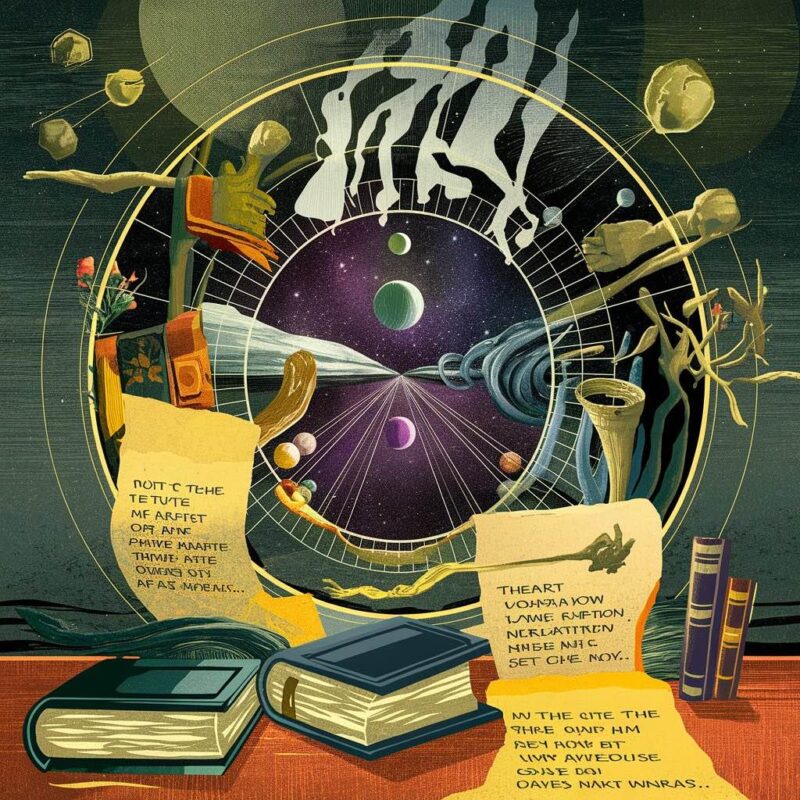Anacoluthon is a figure of speech that alters grammatical flow, leaving a sentence broken, incomplete, or redirected in thought. Writers use it to mirror spontaneity, hesitation, or emotional intensity. Instead of following a neat syntax, the sentence shifts abruptly, as if the writer’s thoughts raced ahead of the structure. In literature, this technique creates texture by giving language the sound of genuine speech, filled with digressions and unexpected turns.
Mechanics of Anacoluthon
At its simplest, anacoluthon occurs when a sentence begins in one syntactic direction but ends in another. Classical rhetoric identified it as an intentional break from expected grammar, often seen in oratory where a speaker abandons a sentence mid-construction. In written form, it captures moments of disorder, urgency, or sudden realization.
For example, William Faulkner’s prose often breaks syntactic order to show mental fragmentation. In the line “Sometimes I ain’t so sho who’s got ere a right to say when a man is crazy and when he ain’t,” the syntax shifts midstream, beginning with a conditional setup and sliding into a contradictory assertion. The unfinished logic mirrors the speaker’s uncertainty, turning the disorder of thought into the disorder of grammar.
Anacoluthon in Rhetoric and Literature
Rhetorical Function
In rhetoric, anacoluthon interrupts linear speech to heighten emphasis or dramatize a shift in thought. It breaks predictability, forcing attention to what follows. Ancient orators used it to mimic the urgency of live speech, while modern writers exploit it to signal psychological turbulence.
Anacoluthon in Poetry
Poets exploit anacoluthon to break rhythm or highlight disjunction. In T. S. Eliot’s The Waste Land (1922), sudden shifts in syntax mirror cultural disintegration and splintered voices. The break in structure contributes to the poem’s jarring cadence, where speech seems constantly interrupted by new voices or stray remnants of memory.
Literary Significance
In literature, anacoluthon conveys character psychology. A disjointed sentence can suggest agitation, self-contradiction, or the slipperiness of memory. It reflects how thought is rarely tidy and shows characters in moments of raw intensity. Writers such as James Joyce, Virginia Woolf, and Samuel Beckett use it in stream-of-consciousness passages, where abrupt syntactic breaks mirror the restless movement of inner life.
Examples of Anacoluthon
- Shakespeare and the dramatic break: In William Shakespeare’s King Lear (1606), Lear cries: “I will have such revenges on you both, that all the world shall—I will do such things—What they are, yet I know not…” The sudden interruption reflects his emotional upheaval. His syntax crumbles under passion.
- Modern fiction: In Franz Kafka’s The Trial (1925), sentences frequently swerve away from completion, expressing bureaucratic absurdity and alienation. The disjointed structures mirror the unstable ground on which Josef K stands.
- Everyday speech: Anacoluthon is also a common feature of spoken language: “If you think I’m going to—well, let’s just say you’re mistaken.” The broken syntax reflects the messiness of actual conversation.
Anacoluthon and Stream of Consciousness
Writers who experiment with stream-of-consciousness narration often rely on anacoluthon. By breaking grammar, they convey thought as it arises: nonlinear, fragmented, and often contradictory. In Virginia Woolf’s Mrs. Dalloway (1925), moments of abrupt shift echo the rhythm of passing thoughts, where one idea overtakes another before completion. Anacoluthon thus becomes a stylistic hallmark of modernist fiction. It aligns grammar with the speed and disorder of consciousness.
The Difference Between Anacoluthon and Aposiopesis
Anacoluthon is often confused with aposiopesis, but the two differ. In aposiopesis, a speaker breaks off suddenly and leaves the sentence unfinished, usually marked by a dash or ellipsis. In anacoluthon, however, the sentence does not simply stop; it continues in an unexpected grammatical form.
Example of aposiopesis: “If you do that again, I swear—”
Example of anacoluthon: “If you do that again, I—well, let’s not discuss it.”
The difference is structural: aposiopesis cuts off the sentence entirely, while anacoluthon carries it forward in a new, unexpected form.
Why Writers Use Anacoluthon
- To express psychological states: Characters under stress or passion often speak in sentences that fracture. Anacoluthon externalizes inner disarray, letting syntax carry emotional force.
- To capture real speech: Few people speak in grammatically pristine sentences. Anacoluthon mirrors real conversation, where abruptness, corrections, and diversions are constant.
- To create emphasis:A sentence that stumbles can direct focus more sharply than one that flows smoothly. By disrupting expectation, the technique makes the reader attentive to what comes next.
Further Reading
Anacoluthon on Wikipedia
Understanding Anacoluthon (Syntactic Blend) in English Grammar by Richard Nordquist
Why do writers use anacoluthon? on Quora




